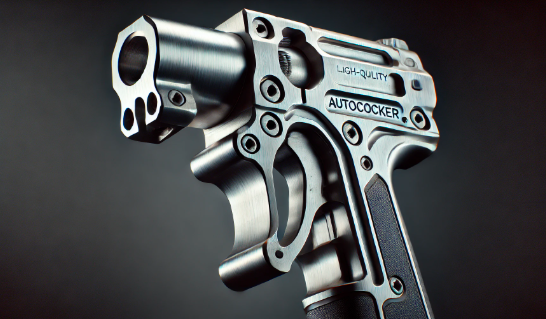
Introduction
Autococker markers have long been a favorite among paintball enthusiasts due to their precision and customizable nature. One crucial component of these markers is the hammer, which plays a significant role in the firing mechanism. The weight of the hammer can impact the performance, efficiency, and reliability of the marker. In this guide, we will explore the heaviest hammer for Autococker markers, why players opt for them, how to install and tune them, and what benefits they offer.
Understanding the Autococker Hammer
The hammer in an Autococker marker is a critical moving part that strikes the valve, allowing air to propel the paintball. The heavier the hammer, the greater the force it applies to the valve, which can influence the marker’s efficiency and performance. Players often look for the heaviest hammer for Autococker markers to enhance consistency and improve the overall feel of the marker. The hammer is usually made from materials like stainless steel, brass, or tungsten to provide different weight options and durability.
Benefits of Using a Heavier Hammer
A heavier hammer offers several advantages for Autococker users, including:
- Increased Consistency – Heavier hammers strike the valve more firmly, ensuring a consistent release of air for each shot.
- Reduced Short Stroking – Short stroking occurs when the trigger pull is incomplete, leading to misfires. A heavier hammer helps mitigate this issue by ensuring a full cycling action.
- Lower Operating Pressure – Heavier hammers allow the marker to function efficiently at lower pressure, reducing wear on internal components and making shots smoother.
- Improved Shot-to-Shot Accuracy – A stable and controlled hammer strike results in a more predictable shot pattern.
- Better Performance with Soft Paint – When playing with fragile paint, a heavier hammer can help in reducing ball breakage due to smoother operation.
Notable Heavy Hammers for Autococker Markers
There are several heavy hammers available for Autococker markers. Some of the most popular ones include:
| Heavy Hammer Model | Material | Weight | Compatibility | Features |
|---|---|---|---|---|
| CCM Autococker Half Block Stainless Steel Hammer | Stainless Steel | 40g | Half-block Autococker markers | Enhances efficiency and reduces short stroking |
| Inception Designs Universal Hammer | Brass | 42g | Full and mid-block Autocockers | Provides smooth cycling and lower pressure operation |
| Shocktech Heavy Hammer | Stainless Steel | 38g | Various Autococker models | Designed for improved consistency and durability |
Installing a Heavy Hammer in an Autococker
Installing the heaviest hammer for an Autococker marker requires precision and proper tuning. Follow these steps to ensure successful installation:
- Disassemble the Marker – Remove the grip frame and back block to access the hammer.
- Remove the Old Hammer – Use an appropriate tool to unscrew and slide out the existing hammer.
- Insert the New Heavy Hammer – Ensure proper alignment before securing it in place.
- Check Spring Compatibility – Adjust the main spring to balance the increased hammer weight.
- Reassemble the Marker – Secure all components and test for proper functionality.
Tuning Your Autococker with a Heavy Hammer
After installing the heaviest hammer for an Autococker, tuning is essential for optimal performance. Here’s how to do it:
- Adjust the IVG (Internal Velocity Governor) – A heavier hammer may require fine-tuning of the IVG to regulate velocity.
- Balance the Valve and Main Springs – Use a spring kit to ensure the correct tension for smooth operation.
- Chronograph Your Marker – Measure the velocity to keep it within field-legal limits and adjust accordingly.
- Lubricate Moving Parts – Regular lubrication prevents excessive wear and ensures reliable function.
Potential Drawbacks and Considerations
While a heavier hammer offers many advantages, there are a few considerations to keep in mind:
- Increased Wear on Internal Components – More forceful strikes may lead to faster wear on the valve and springs.
- More Frequent Maintenance Required – Regular inspections are necessary to maintain smooth performance.
- Weight vs. Speed Trade-off – Some players prefer lighter hammers for a faster cycle rate, depending on their play style.
User Experiences and Testimonials
Many Autococker users have reported positive experiences after upgrading to a heavier hammer. Players have noted increased shot-to-shot consistency, better control over velocity, and improved efficiency. However, some users prefer a balanced setup with moderate hammer weight to maintain a faster cycle rate. Ultimately, choosing the heaviest hammer for an Autococker depends on individual playing styles and preferences.
Conclusion
Upgrading to the heaviest hammer for an Autococker marker can significantly enhance performance, offering improved consistency, reduced short stroking, and lower operating pressure. However, proper installation and tuning are essential to reap the full benefits. Whether you are an experienced Autococker user or a newcomer looking to optimize your marker, understanding the role of a heavy hammer can help you make an informed decision.
Related Articles
Understanding the ‘xai890k’ Cryptocurrency Scam
Everything You Need to Know About Holy Water Bracelets: History, Significance, and Usage
Everything You Need to Know About Turkey Doubles Tournament T-Shirts






